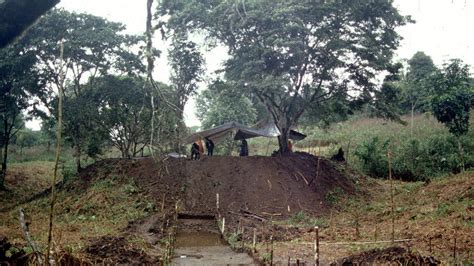
Archaeologists have discovered a lost city in the cloud forests of Ecuador, uncovering over 100 ancient structures believed to be part of a previously unknown pre-Hispanic civilization. The find includes platforms, roads, and various artifacts, offering significant insights into the region’s rich past and the complex societies that once thrived there.
Researchers, initially focused on studying the Inca presence in the area, stumbled upon the extensive network of constructions between 1993 and 2003, but only recently published their findings. These structures, located in the Upano Valley on the eastern slopes of the Andes, suggest a civilization that flourished for nearly a thousand years, from around 500 AD to 1400 AD, before the Inca Empire expanded into the region.
“We found a cluster of platforms and structures that was very different,” said archaeologist Stéphen Rostain, director of research at the French National Centre for Scientific Research (CNRS), who led the study published in the journal Science. Rostain noted that the scale of the site was unexpected, revealing a more complex and densely populated society than previously imagined.
The discovery challenges long-held beliefs about pre-Columbian societies in the Amazon basin, which were often viewed as sparsely populated and less developed than their Andean counterparts. The Upano Valley site indicates a sophisticated urban development with well-planned settlements and agricultural practices, suggesting a population potentially reaching tens of thousands at its peak.
The dense network of platforms, typically measuring about 20 by 10 meters and standing two to three meters high, were constructed from precisely cut stone blocks. These platforms likely served as foundations for residential and ceremonial buildings. Surrounding these platforms is an intricate system of roads and pathways, connecting the various settlements and suggesting a high degree of social organization and coordination.
Lidar (Light Detection and Ranging) technology played a crucial role in mapping the site. By emitting laser pulses from an aircraft, Lidar can penetrate the dense forest canopy and create detailed 3D models of the terrain beneath. This technology allowed researchers to identify and map the structures hidden beneath the vegetation, revealing the true extent of the lost city.
The team also discovered evidence of sophisticated agricultural practices, including drainage canals and terraced fields, which would have allowed the civilization to sustain a large population. This suggests that the Upano people were skilled farmers who had adapted to the challenging environment of the cloud forest.
Archaeological finds at the site include pottery shards, stone tools, and evidence of dwellings, providing a glimpse into the daily lives of the people who once inhabited the city. Further analysis of these artifacts could shed more light on the cultural practices, beliefs, and social structures of the Upano civilization.
The discovery of the Upano Valley site has significant implications for our understanding of pre-Columbian history. It suggests that the Amazon basin was home to more complex and developed societies than previously thought, and that these societies played an important role in the broader history of South America.
The findings have prompted calls for further research and conservation efforts to protect the site from looting and environmental damage. The Ecuadorian government has expressed interest in developing the site as a tourist destination, which could bring economic benefits to the region while also raising awareness of its rich cultural heritage.
The study published in Science is just the beginning of what promises to be a long and fascinating journey of discovery. As archaeologists continue to explore the Upano Valley, they are likely to uncover even more secrets about the lost city and the civilization that built it. The discovery serves as a reminder of the importance of preserving our cultural heritage and the potential for new discoveries to reshape our understanding of the past.
Detailed Exploration and Context
The rediscovery of the Upano Valley settlements provides critical insights into a little-known chapter of pre-Columbian history. While the Inca Empire is widely recognized, the existence and sophistication of earlier societies in the Amazonian regions are often overlooked. This discovery compels a reevaluation of the historical narratives and challenges conventional assumptions about the development and complexity of ancient civilizations in South America.
Geographical and Environmental Context
The Upano Valley, nestled in the eastern Andean foothills, is characterized by a unique cloud forest environment. This region experiences high levels of rainfall and humidity, resulting in dense vegetation and challenging conditions for both human habitation and archaeological investigation. The resilience of the Upano civilization is evident in their ability to adapt to and thrive in this demanding environment.
The strategic location of the Upano Valley likely played a crucial role in the development of the civilization. Situated at the intersection of the Andes and the Amazon basin, the valley may have served as a trade route and cultural exchange hub. The fertile soils and abundant water resources would have supported agricultural production, while the surrounding forests provided timber and other valuable resources.
Architectural and Urban Planning
The architectural design and urban planning of the Upano Valley settlements reflect a high degree of sophistication and social organization. The platforms, constructed from carefully cut stone blocks, provide stable foundations for buildings in the rugged terrain. The arrangement of the platforms and the interconnected network of roads and pathways suggest a deliberate and well-planned urban layout.
The size and complexity of the settlements indicate a significant investment of labor and resources. The construction of the platforms, roads, and drainage systems would have required a large workforce and skilled engineers. This suggests a hierarchical social structure with the capacity to mobilize and coordinate collective efforts.
The uniformity of the platform design and construction techniques across the Upano Valley suggests a shared cultural identity and a centralized system of governance. This contrasts with other pre-Columbian societies in the Amazon basin, which were often characterized by decentralized political structures and diverse cultural traditions.
Agricultural Practices and Sustainability
The agricultural practices of the Upano civilization were essential for sustaining a large population in the cloud forest environment. The discovery of drainage canals and terraced fields indicates a sophisticated understanding of water management and soil conservation. These techniques would have allowed the Upano people to cultivate crops in the steep slopes and manage the high levels of rainfall.
The types of crops grown by the Upano civilization are not yet fully known, but it is likely that they cultivated a variety of plants adapted to the local environment. Maize, beans, squash, and tubers may have been staples of their diet. The cultivation of these crops would have provided a reliable food supply and supported a growing population.
The agricultural practices of the Upano civilization were likely sustainable in the long term. By carefully managing water resources and conserving soil fertility, the Upano people were able to maintain agricultural productivity for centuries. This suggests a deep understanding of the ecological processes and a commitment to environmental stewardship.
Cultural and Social Organization
The cultural and social organization of the Upano civilization remains largely unknown, but the archaeological evidence provides some clues. The uniformity of the architectural design and construction techniques suggests a shared cultural identity and a centralized system of governance. The presence of ceremonial structures indicates the importance of religious rituals and social gatherings.
The discovery of pottery shards and stone tools provides insights into the daily lives of the Upano people. The pottery shards may reveal information about their culinary practices, artistic traditions, and trade networks. The stone tools may indicate their technological capabilities and their reliance on natural resources.
Further analysis of the archaeological finds could shed more light on the social hierarchy, political organization, and religious beliefs of the Upano civilization. This could involve studying the distribution of artifacts across the site, analyzing the burial practices of the Upano people, and comparing their cultural traditions with those of other pre-Columbian societies in the region.
Dating and Chronology
The dating of the Upano Valley settlements to between 500 AD and 1400 AD is based on radiocarbon dating of organic materials found at the site. This dating places the Upano civilization within the Late Regional Development period in the Andean region, a time of significant cultural and social change.
The Upano civilization flourished for nearly a thousand years before the Inca Empire expanded into the region. This suggests that the Upano people were able to maintain their independence and cultural identity despite the growing influence of the Inca. The eventual decline of the Upano civilization may have been due to a combination of factors, including environmental changes, social unrest, and external pressures.
Further research is needed to refine the dating and chronology of the Upano Valley settlements. This could involve obtaining additional radiocarbon dates, analyzing the stratigraphy of the site, and comparing the archaeological finds with those of other pre-Columbian sites in the region.
The Role of Lidar Technology
The use of Lidar technology was crucial in the discovery and mapping of the Upano Valley settlements. Lidar, which stands for Light Detection and Ranging, is a remote sensing technology that uses laser pulses to create detailed 3D models of the terrain beneath the forest canopy.
Lidar works by emitting laser pulses from an aircraft and measuring the time it takes for the pulses to return to the sensor. This information is used to calculate the distance to the ground and create a detailed map of the terrain. Lidar can penetrate the dense vegetation of the cloud forest, allowing researchers to identify and map structures that would otherwise be hidden from view.
The Lidar survey of the Upano Valley revealed a vast network of platforms, roads, and other structures that had been obscured by vegetation for centuries. This allowed researchers to gain a comprehensive understanding of the scale and complexity of the settlements.
Lidar technology is becoming increasingly important in archaeological research, particularly in tropical regions where dense vegetation makes it difficult to conduct traditional ground surveys. Lidar can help researchers to identify and map archaeological sites more quickly and efficiently, and it can also provide valuable information about the landscape and the environment.
Comparison with Other Pre-Columbian Civilizations
The discovery of the Upano Valley settlements provides an opportunity to compare the Upano civilization with other pre-Columbian societies in South America. The Upano civilization shares some similarities with the better-known Andean civilizations, such as the Inca and the Moche, but it also has its own unique characteristics.
Like the Andean civilizations, the Upano civilization was a complex society with a hierarchical social structure and a centralized system of governance. The Upano people were skilled engineers and architects, as evidenced by the construction of the platforms, roads, and drainage systems. They were also skilled farmers who were able to sustain a large population in a challenging environment.
However, the Upano civilization also differed from the Andean civilizations in some important ways. The Upano settlements were located in the Amazonian region, rather than the Andean highlands. The Upano people developed their own unique cultural traditions and artistic styles. And they were not as politically centralized as the Inca Empire.
The comparison of the Upano civilization with other pre-Columbian societies can help us to better understand the diversity and complexity of the ancient world. It can also shed light on the factors that contributed to the rise and fall of civilizations.
Conservation and Management Challenges
The discovery of the Upano Valley settlements poses significant challenges for conservation and management. The site is located in a remote and ecologically sensitive area, and it is vulnerable to looting, environmental damage, and unsustainable tourism.
The Ecuadorian government has expressed interest in developing the site as a tourist destination, which could bring economic benefits to the region while also raising awareness of its rich cultural heritage. However, it is important to ensure that tourism is managed in a sustainable way that protects the site from damage and preserves its cultural integrity.
Conservation efforts should focus on protecting the site from looting and vandalism, stabilizing the structures, and controlling vegetation growth. It is also important to engage with local communities and involve them in the conservation and management of the site.
The long-term preservation of the Upano Valley settlements will require a collaborative effort involving archaeologists, conservationists, local communities, and the Ecuadorian government. By working together, we can ensure that this important archaeological site is protected for future generations.
Future Research Directions
The discovery of the Upano Valley settlements has opened up new avenues for archaeological research. Future research should focus on several key areas:
- Excavation: Further excavation of the site is needed to uncover more artifacts and structural remains. This could involve systematically excavating selected platforms, roads, and other features.
- Analysis of Artifacts: The artifacts recovered from the site should be analyzed to learn more about the daily lives, cultural practices, and trade networks of the Upano people. This could involve studying the pottery shards, stone tools, and other objects.
- Environmental Reconstruction: Reconstructing the environment of the Upano Valley during the time of the Upano civilization can provide insights into their agricultural practices and their adaptation to the cloud forest environment. This could involve studying pollen samples, soil samples, and other environmental data.
- Comparison with Other Sites: Comparing the Upano Valley settlements with other pre-Columbian sites in the region can help us to better understand the cultural connections and trade networks of the Upano civilization. This could involve comparing the architectural styles, artifact assemblages, and environmental data.
- Community Engagement: Engaging with local communities and involving them in the research process can help to ensure that the research is conducted in a responsible and ethical manner. This could involve consulting with local communities about the research questions, sharing the research findings with them, and involving them in the conservation and management of the site.
By pursuing these research directions, we can continue to learn more about the Upano civilization and its place in the history of South America. The Upano Valley settlements represent a valuable resource for understanding the past, and they have the potential to reshape our understanding of pre-Columbian history.
The Significance of the Discovery
The rediscovery of the Upano Valley settlements is a monumental event in the field of archaeology. It challenges long-held assumptions about the development and complexity of pre-Columbian societies in the Amazon basin and opens up new avenues for research and exploration.
The discovery underscores the importance of preserving our cultural heritage and the potential for new discoveries to reshape our understanding of the past. It also highlights the value of interdisciplinary collaboration, bringing together archaeologists, environmental scientists, and local communities to unlock the secrets of the past.
The Upano Valley settlements stand as a testament to the ingenuity, resilience, and cultural achievements of the Upano civilization. Their legacy serves as a reminder of the rich and diverse history of South America and the importance of learning from the past to build a better future.
Frequently Asked Questions (FAQ)
-
Where exactly is the lost city located? The lost city is located in the Upano Valley on the eastern slopes of the Andes Mountains in Ecuador. This region is characterized as a cloud forest.
-
When did the Upano civilization flourish? The Upano civilization flourished from approximately 500 AD to 1400 AD, predating the Inca Empire’s expansion into the area.
-
How were these structures discovered? While initial reconnaissance occurred between 1993 and 2003, the structures were comprehensively mapped using Lidar (Light Detection and Ranging) technology, which allowed researchers to penetrate the dense forest canopy and reveal the hidden constructions.
-
What are the key features of the lost city? The lost city consists of over 100 platforms constructed from precisely cut stone, interconnected by an intricate network of roads and pathways. Additionally, there’s evidence of sophisticated agricultural practices like drainage canals and terraced fields.
-
What does this discovery tell us about pre-Columbian societies in the Amazon? The discovery challenges the traditional view of pre-Columbian Amazonian societies as sparsely populated and less developed. It suggests the presence of a complex, densely populated civilization with advanced urban planning and agricultural techniques.









